warning light NISSAN FRONTIER 2022 Owner´s Manual
[x] Cancel search | Manufacturer: NISSAN, Model Year: 2022, Model line: FRONTIER, Model: NISSAN FRONTIER 2022Pages: 556, PDF Size: 6.11 MB
Page 3 of 556
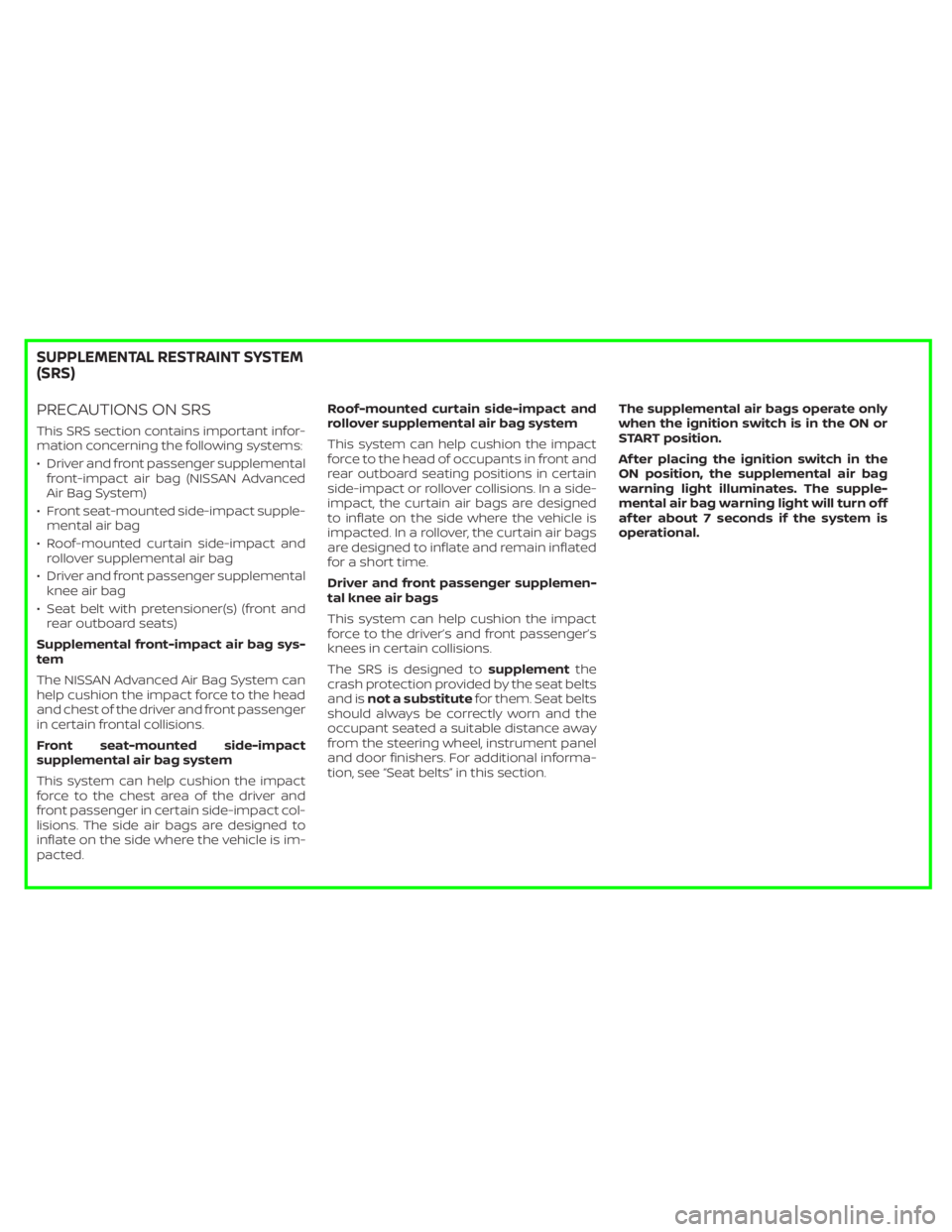
PRECAUTIONS ON SRS
This SRS section contains important infor-
mation concerning the following systems:
• Driver and front passenger supplementalfront-impact air bag (NISSAN Advanced
Air Bag System)
• Front seat-mounted side-impact supple- mental air bag
• Roof-mounted curtain side-impact and rollover supplemental air bag
• Driver and front passenger supplemental knee air bag
• Seat belt with pretensioner(s) (front and rear outboard seats)
Supplemental front-impact air bag sys-
tem
The NISSAN Advanced Air Bag System can
help cushion the impact force to the head
and chest of the driver and front passenger
in certain frontal collisions.
Front seat-mounted side-impact
supplemental air bag system
This system can help cushion the impact
force to the chest area of the driver and
front passenger in certain side-impact col-
lisions. The side air bags are designed to
inflate on the side where the vehicle is im-
pacted. Roof-mounted curtain side-impact and
rollover supplemental air bag system
This system can help cushion the impact
force to the head of occupants in front and
rear outboard seating positions in certain
side-impact or rollover collisions. In a side-
impact, the curtain air bags are designed
to inflate on the side where the vehicle is
impacted. In a rollover, the curtain air bags
are designed to inflate and remain inflated
for a short time.
Driver and front passenger supplemen-
tal knee air bags
This system can help cushion the impact
force to the driver’s and front passenger’s
knees in certain collisions.
The SRS is designed to
supplementthe
crash protection provided by the seat belts
and is not a substitute for them. Seat belts
should always be correctly worn and the
occupant seated a suitable distance away
from the steering wheel, instrument panel
and door finishers. For additional informa-
tion, see “Seat belts” in this section. The supplemental air bags operate only
when the ignition switch is in the ON or
START position.
Af ter placing the ignition switch in the
ON position, the supplemental air bag
warning light illuminates. The supple-
mental air bag warning light will turn off
af ter about 7 seconds if the system is
operational.
SUPPLEMENTAL RESTRAINT SYSTEM
(SRS)
Page 4 of 556
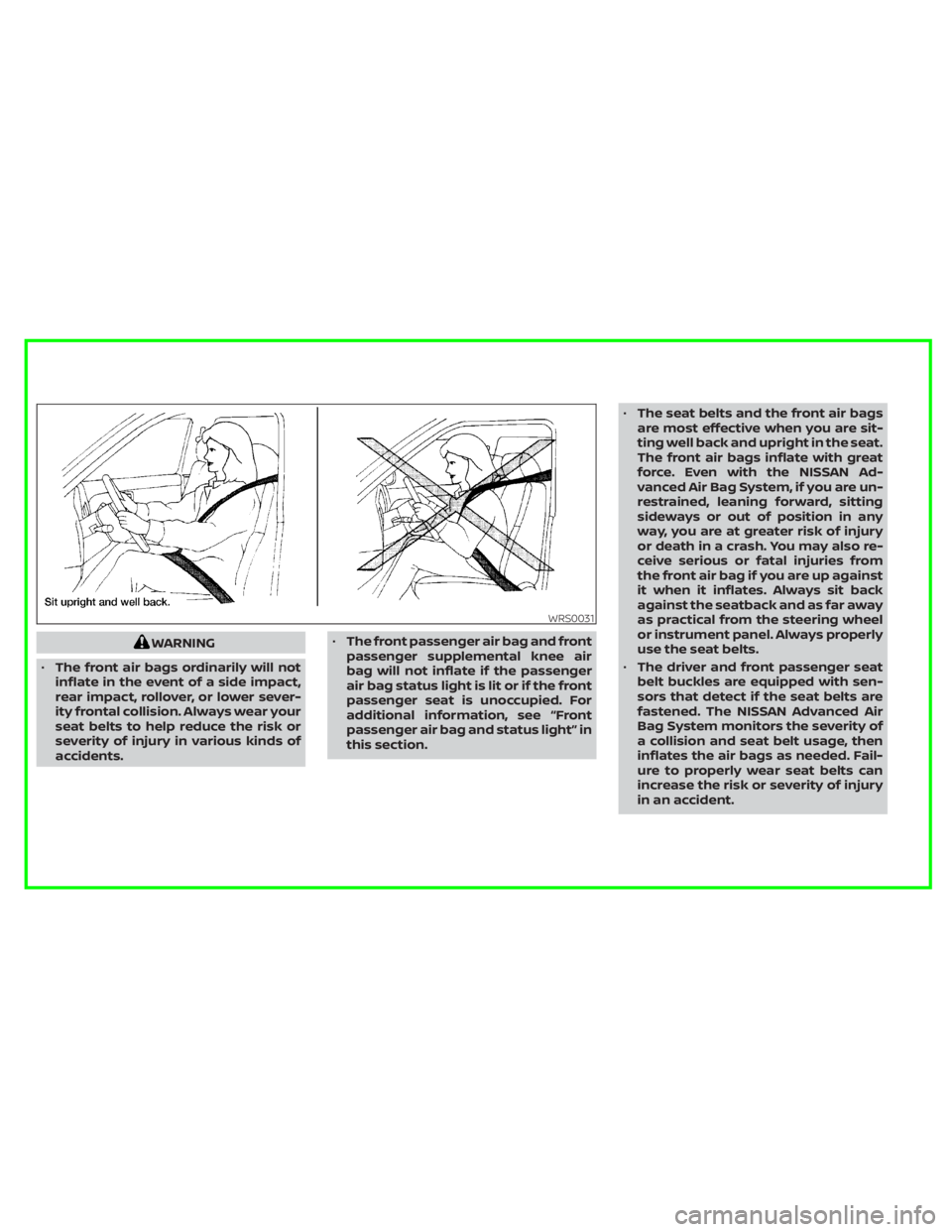
WARNING
• The front air bags ordinarily will not
inflate in the event of a side impact,
rear impact, rollover, or lower sever-
ity frontal collision. Always wear your
seat belts to help reduce the risk or
severity of injury in various kinds of
accidents. •
The front passenger air bag and front
passenger supplemental knee air
bag will not inflate if the passenger
air bag status light is lit or if the front
passenger seat is unoccupied. For
additional information, see “Front
passenger air bag and status light” in
this section. •
The seat belts and the front air bags
are most effective when you are sit-
ting well back and upright in the seat.
The front air bags inflate with great
force. Even with the NISSAN Ad-
vanced Air Bag System, if you are un-
restrained, leaning forward, sitting
sideways or out of position in any
way, you are at greater risk of injury
or death in a crash. You may also re-
ceive serious or fatal injuries from
the front air bag if you are up against
it when it inflates. Always sit back
against the seatback and as far away
as practical from the steering wheel
or instrument panel. Always properly
use the seat belts.
• The driver and front passenger seat
belt buckles are equipped with sen-
sors that detect if the seat belts are
fastened. The NISSAN Advanced Air
Bag System monitors the severity of
a collision and seat belt usage, then
inflates the air bags as needed. Fail-
ure to properly wear seat belts can
increase the risk or severity of injury
in an accident.
WRS0031
Page 17 of 556
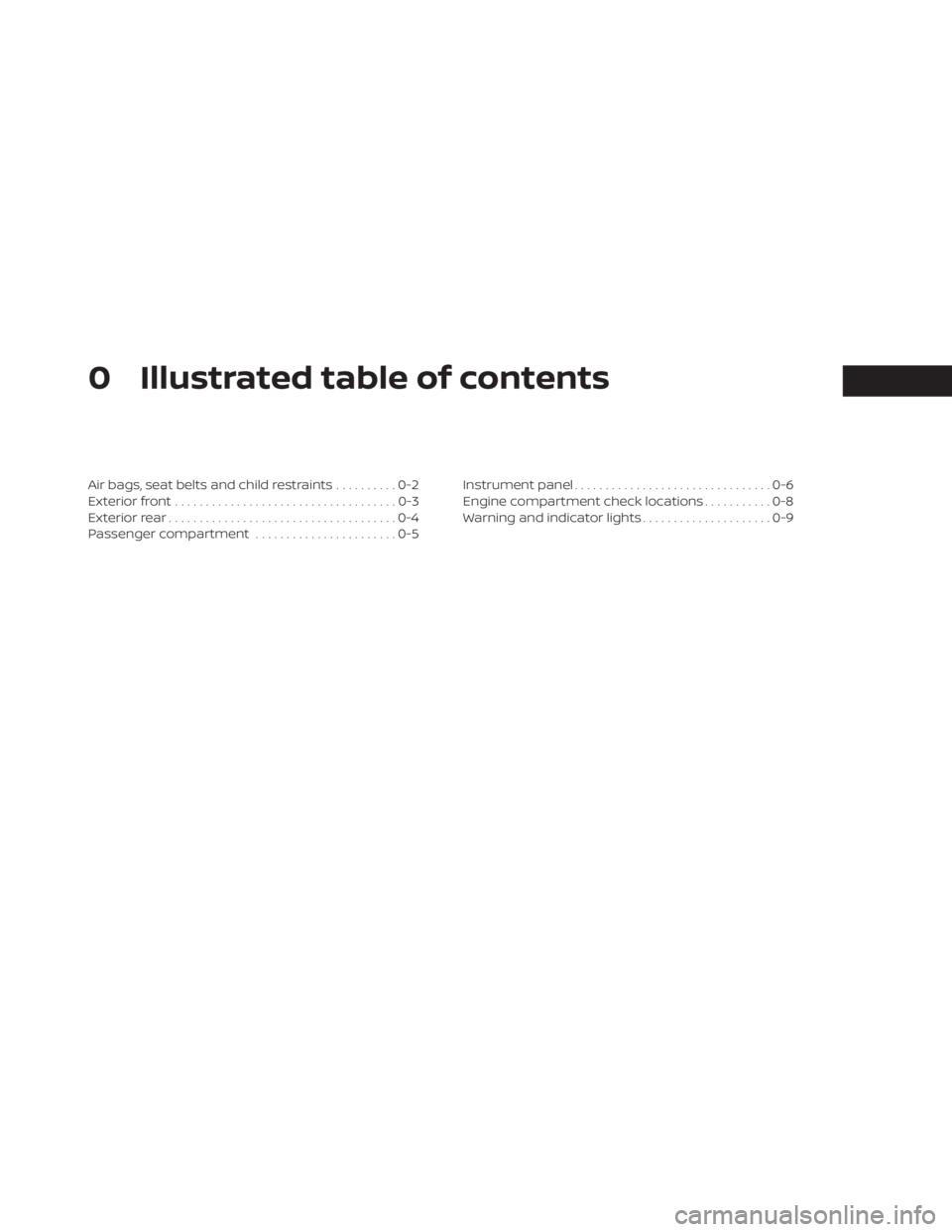
0 Illustrated table of contents
Air bags, seat belts and child restraints..........0-2
Exterior front ....................................0-3
Exterior rear .....................................0-4
Passenger compartment .......................0-5 Instrument panel
................................0-6
Engine compartment check locations ...........0-8
Warning and indicator lights .....................0-9
Page 22 of 556
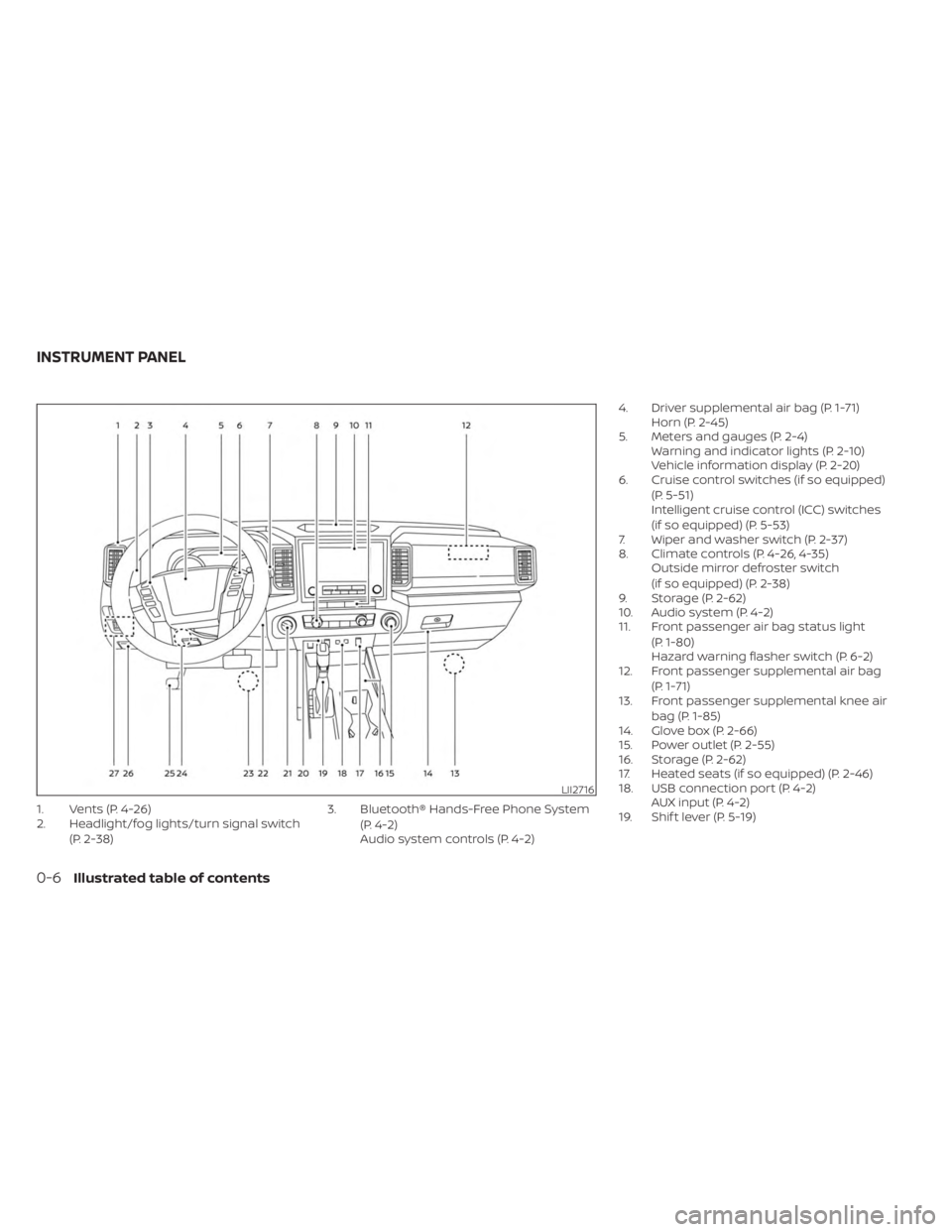
1. Vents (P. 4-26)
2. Headlight/fog lights/turn signal switch(P. 2-38) 3. Bluetooth® Hands-Free Phone System
(P. 4-2)
Audio system controls (P. 4-2) 4. Driver supplemental air bag (P. 1-71)
Horn (P. 2-45)
5. Meters and gauges (P. 2-4) Warning and indicator lights (P. 2-10)
Vehicle information display (P. 2-20)
6. Cruise control switches (if so equipped)
(P. 5-51)
Intelligent cruise control (ICC) switches
(if so equipped) (P. 5-53)
7. Wiper and washer switch (P. 2-37)
8. Climate controls (P. 4-26, 4-35) Outside mirror defroster switch
(if so equipped) (P. 2-38)
9. Storage (P. 2-62)
10. Audio system (P. 4-2)
11. Front passenger air bag status light
(P. 1-80)
Hazard warning flasher switch (P. 6-2)
12. Front passenger supplemental air bag
(P. 1-71)
13. Front passenger supplemental knee air
bag (P. 1-85)
14. Glove box (P. 2-66)
15. Power outlet (P. 2-55)
16. Storage (P. 2-62)
17. Heated seats (if so equipped) (P. 2-46)
18. USB connection port (P. 4-2) AUX input (P. 4-2)
19. Shif t lever (P. 5-19)
LII2716
INSTRUMENT PANEL
0-6Illustrated table of contents
Page 25 of 556
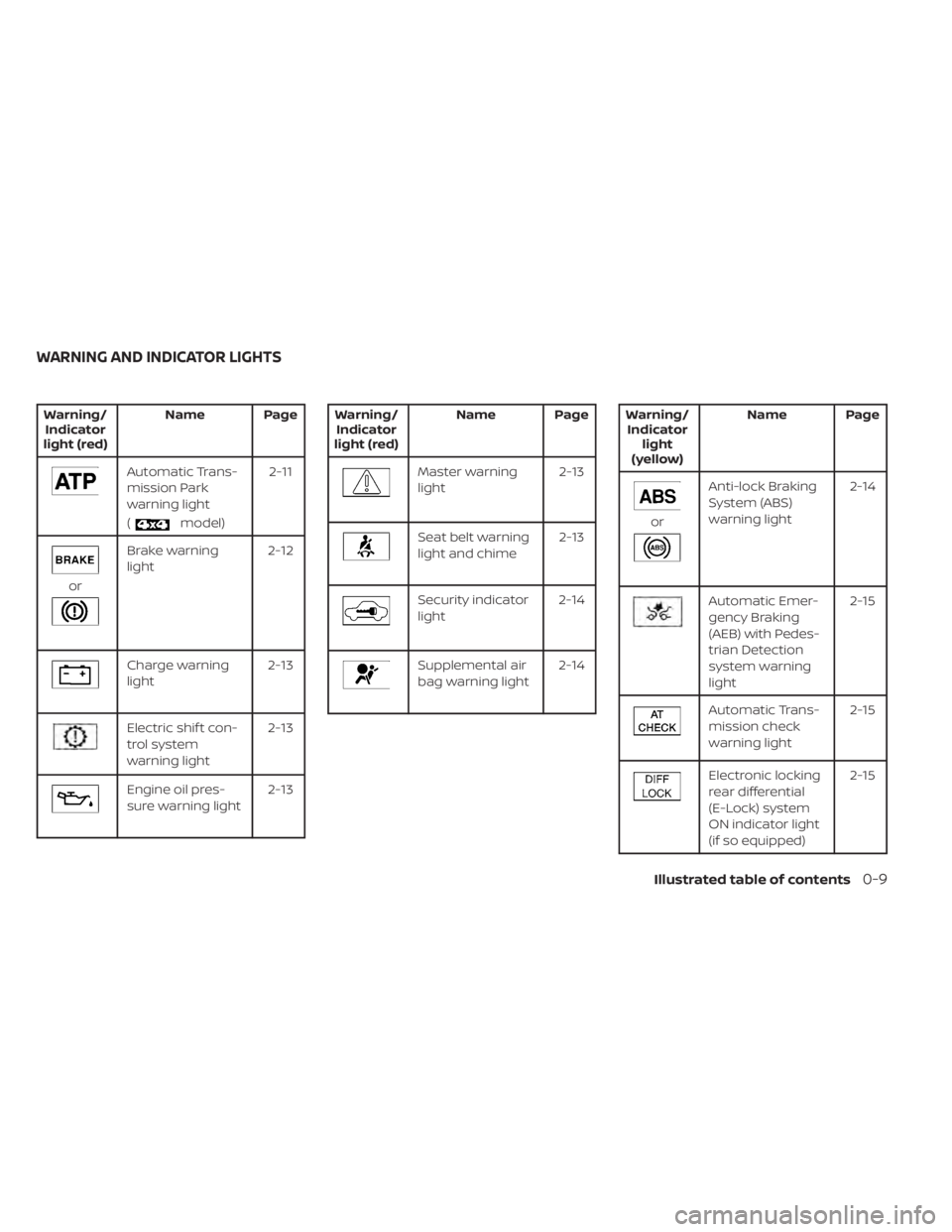
Warning/Indicator
light (red) Name Page
Automatic Trans-
mission Park
warning light
(
model)2-11
or
Brake warning
light
2-12
Charge warning
light 2-13
Electric shif t con-
trol system
warning light2-13
Engine oil pres-
sure warning light
2-13
Warning/
Indicator
light (red) Name Page
Master warning
light
2-13
Seat belt warning
light and chime2-13
Security indicator
light2-14
Supplemental air
bag warning light2-14
Warning/
Indicator light
(yellow) Name Page
or
Anti-lock Braking
System (ABS)
warning light
2-14
Automatic Emer-
gency Braking
(AEB) with Pedes-
trian Detection
system warning
light 2-15
Automatic Trans-
mission check
warning light
2-15
Electronic locking
rear differential
(E-Lock) system
ON indicator light
(if so equipped)2-15
WARNING AND INDICATOR LIGHTS
Illustrated table of contents0-9
Page 26 of 556
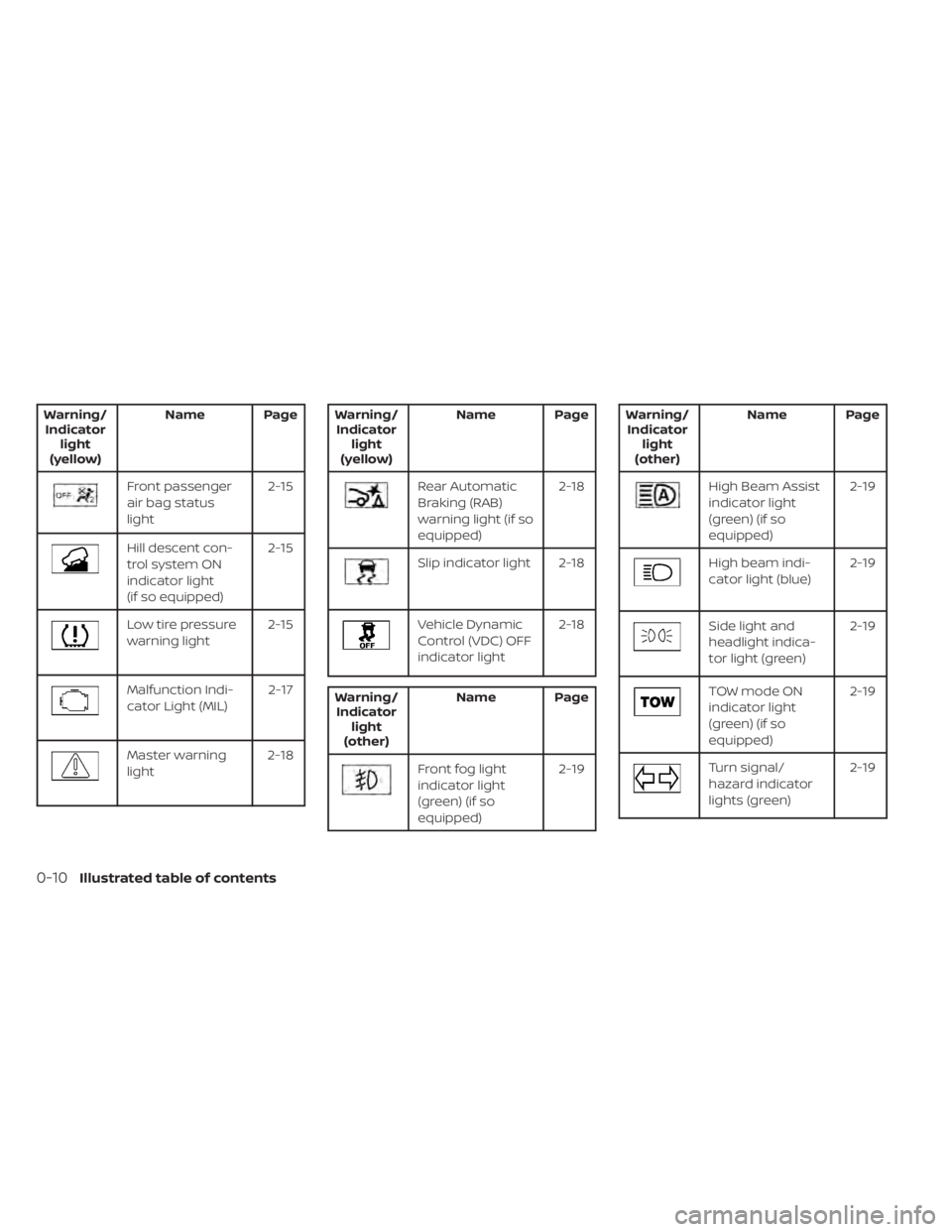
Warning/Indicator light
(yellow) Name Page
Front passenger
air bag status
light
2-15
Hill descent con-
trol system ON
indicator light
(if so equipped)2-15
Low tire pressure
warning light
2-15
Malfunction Indi-
cator Light (MIL) 2-17
Master warning
light2-18
Warning/
Indicator light
(yellow) Name Page
Rear Automatic
Braking (RAB)
warning light (if so
equipped) 2-18
Slip indicator light 2-18
Vehicle Dynamic
Control (VDC) OFF
indicator light
2-18
Warning/
Indicator light
(other) Name Page
Front fog light
indicator light
(green) (if so
equipped) 2-19
Warning/
Indicator light
(other) Name Page
High Beam Assist
indicator light
(green) (if so
equipped) 2-19
High beam indi-
cator light (blue)
2-19
Side light and
headlight indica-
tor light (green)2-19
TOW mode ON
indicator light
(green) (if so
equipped)2-19
Turn signal/
hazard indicator
lights (green)
2-19
0-10Illustrated table of contents
Page 28 of 556
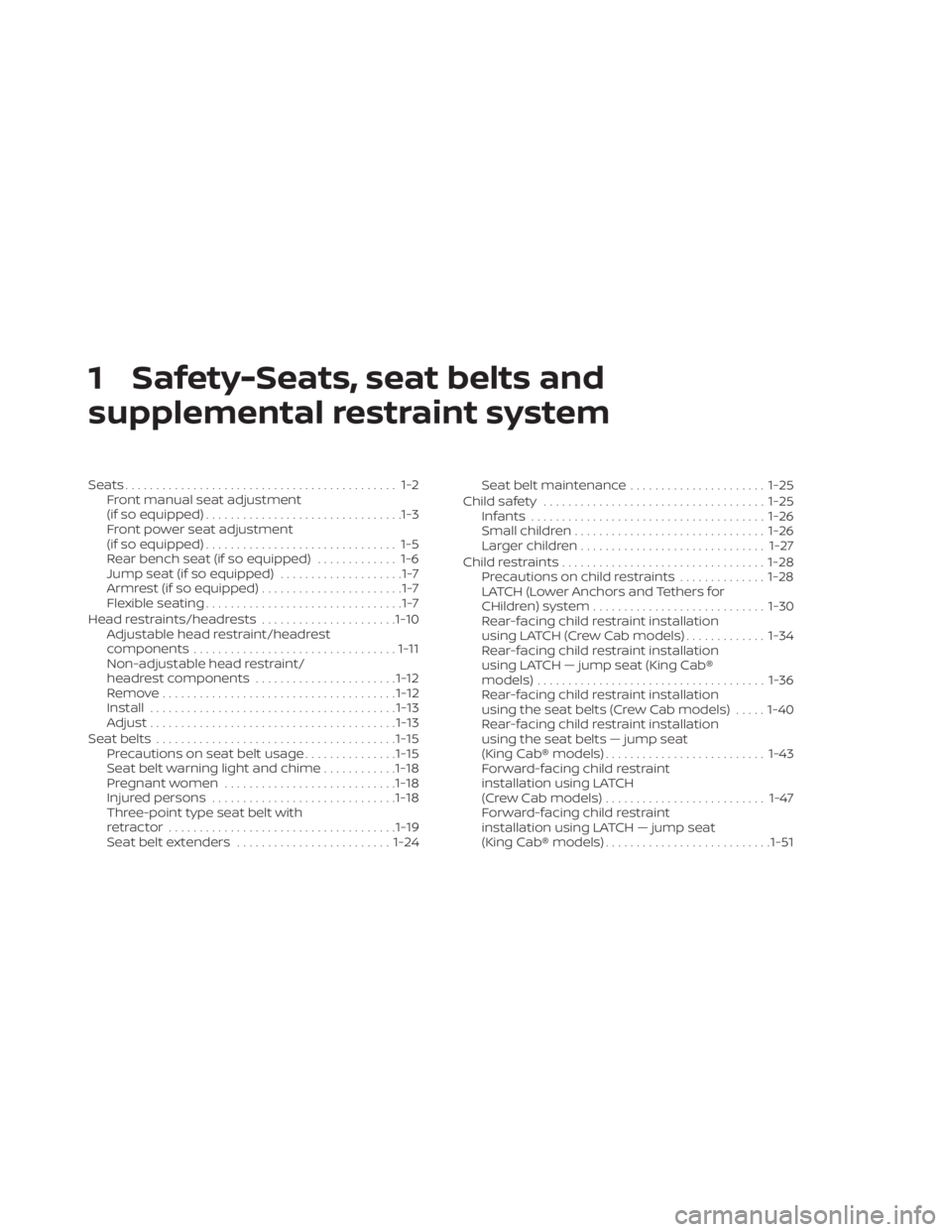
1 Safety-Seats, seat belts and
supplemental restraint system
Seats............................................ 1-2Front manual seat adjustment
(if so equipped) ................................1-3
Front power seat adjustment
(if so equipped) ............................... 1-5
Rear bench seat (if so equipped) ............. 1-6
Jump seat (if so equipped) ....................1-7
Armrest (if so equipped) .......................1-7
Flexible seating ................................1-7
Head restraints/headrests ......................1-10
Adjustable head restraint/headrest
components ................................. 1-11
Non-adjustable head restraint/
headrest components .......................1-12
Remove...................................... 1-12
Install ........................................ 1-13
Adjust ........................................ 1-13
Seatbelts ....................................... 1-15
Precautions on seat belt usage ...............1-15
Seat belt warning light and chime ............1-18
Pregnant women ............................ 1-18
Injured persons .............................. 1-18
Three-point type seat belt with
retractor ..................................... 1-19
Seat belt extenders ......................... 1-24Seat belt maintenance
......................1-25
Child safety .................................... 1-25
Infants ...................................... 1-26
Small children ............................... 1-26
Larger children .............................. 1-27
Child restraints ................................. 1-28
Precautions on child restraints ..............1-28
LATCH (Lower Anchors and Tethers for
CHildren) system ............................ 1-30
Rear-facing child restraint installation
using LATCH (Crew Cab models) .............1-34
Rear-facing child restraint installation
using LATCH — jump seat (King Cab®
models) ..................................... 1-36
Rear-facing child restraint installation
using the seat belts (Crew Cab models) .....1-40
Rear-facing child restraint installation
using the seat belts — jump seat
(King Cab® models) .......................... 1-43
Forward-facing child restraint
installation using LATCH
(Crew Cab models) .......................... 1-47
Forward-facing child restraint
installation using LATCH — jump seat
(King Cab® models) ........................... 1-51
Page 29 of 556

Forward-facing child restraint
installation using the seat belts — front
passenger and rear bench seat
(Crew Cab models).......................... 1-55
Forward-facing child restraint
installation using the seat belts — front
passenger and jump seats
(King Cab® models) ..........................1-60 Booster seats
............................... 1-66
Supplemental Restraint System (SRS) ...........1-71
Precautions on SRS .......................... 1-71
Supplemental air bag warning labels ........1-88
Supplemental air bag warning light .........1-88
Page 45 of 556

WARNING
• Always route the shoulder belt over
your shoulder and across your chest.
Never put the belt behind your back,
under your arm or across your neck.
The belt should be away from your
face and neck, but not falling off your
shoulder.
• Position the lap belt as low and snug
as possible AROUND THE HIPS, NOT
THE WAIST. A lap belt worn too high
could increase the risk of internal in-
juries in an accident. •
Be sure the seat belt tongue is se-
curely fastened to the proper buckle.
• Do not wear the seat belt inside out
or twisted. Doing so may reduce its
effectiveness.
• Do not allow more than one person
to use the same seat belt.
• Never carry more people in the ve-
hicle than there are seat belts.
• If the seat belt warning light glows
continuously while the ignition is
placed in the ON position with all
doors closed and all seat belts fas-
tened, it may indicate a malfunction
in the system. Have the system
checked. It is recommended that you
visit a NISSAN dealer for this service.
• No changes should be made to the
seat belt system. For example, do not
modif y the seat belt, add material, or
install devices that may change the
seat belt routing or tension. Doing so
may affect the operation of the seat
belt system. Modif ying or tampering
with the seat belt system may result
in serious personal injury. •
Once seat belt pretensioner(s) have
activated, they cannot be reused and
must be replaced together with the
retractor. It is recommended that you
visit a NISSAN dealer for this service.
• All seat belt assemblies, including re-
tractors and attaching hardware,
should be inspected af ter any colli-
sion. It is recommended that you visit
a NISSAN dealer for this service.
NISSAN recommends that all seat
belt assemblies in use during a colli-
sion be replaced unless the collision
was minor and the belts show no
damage and continue to operate
properly. Seat belt assemblies not in
use during a collision should also be
inspected and replaced if either
damage or improper operation is
noted.
•
All child restraints and attaching hard-
ware should be inspected af ter any
collision. Always follow the restraint
manufacturer's inspection instruc-
tions and replacement recommenda-
tions. The child restraints should be re-
placed if they are damaged.
SSS0014
Safety-Seats, seat belts and supplemental restraint system1-17
Page 46 of 556

SEAT BELT WARNING LIGHT AND
CHIME
The driver and front passenger seat is
equipped with an enhanced seat belt re-
minder function. If your vehicle is equipped
with an enhanced seat belt reminder func-
tion, a visual and audible alert (Driver’s seat
only) will operate if a driver or front passen-
ger seat belt is unbuckled at speeds of ap-
proximately 9 mph (15 km/h) or more un-
der the following conditions:
• If the driver seat belt is not fastened.• The front passenger’s seat belt is not fas-
tened and the seat is occupied by a pas-
senger for 7 seconds af ter the ignition
switch is placed in the ON position.
• The front passenger’s seat belt is not fas- tened and objects or external force on
the passenger seat change the seat belt
reminder classification to Occupied.
The seat belt warning light will flash under
the conditions shown above until the nec-
essary seat belt is securely fastened.
A warning chime will sound for approxi-
mately 90 seconds or until one of the fol-
lowing conditions is met:
• The unbuckled front occupant’s seat belt is securely fastened.
• The ignition is placed in the OFF position.
The below situations could result in the
seat belt reminder light being illuminated
and the chime sounding (Driver’s seat only),
even with no occupant present in the pas-
senger seat:
• Heavy objects placed on the seat.
• Someone pushing or pulling on the front passenger seat.
• An object placed under the front passen- ger seat. • An object placed between the seat cush-
ion and center console or between the
seat cushion and the door.
• An object hanging on the seat or placed in the seatback pocket.
• A child restraint or other object pressing against the rear of the seatback.
PREGNANT WOMEN
NISSAN recommends that pregnant
women use seat belts. The seat belt should
be worn snug and always position the lap
belt as low as possible around the hips, not
the waist. Place the shoulder belt over your
shoulder and across your chest. Never run
the lap/shoulder belt over your abdominal
area. Contact your doctor for specific
recommendations.
INJURED PERSONS
NISSAN recommends that injured persons
use seat belts. Check with your doctor for
specific recommendations.
LRS0786
1-18Safety-Seats, seat belts and supplemental restraint system